Fast Tool for Structural Monitoring of a Pier After Impact of a Very Large Vessel Using Ambient Vibration Analysis
2021-09-10ThiagoHenriqueWalnorioFerreiraCludioMartins
Thiago Henrique · Walnorio Ferreira · Cláudio Martins
Abstract Operational modal analysis is a non-destructive structural investigation that considers only the loads resulting from service conditions. This approach allows the measurement of vibrations on a given structure with no need to interrupt its use. The present work aims to develop a numerical model to represent the global structural behavior of a vessel breasting dolphin using a technique that is simple and cheap in order to obtain a fast answer about the stiffness of a pier after the collision of ships with capacity up to 400,000t. To determine the modes of vibration, one accelerometer was installed on the breasting dolphin located on the pier and a frequency domain technic was conducted over recorded data to obtain modal parameters of the structure. In situ measurements were compared to data from a finite element model based on the original structural design in order to adapt the model to accurately represent the actual behavior of the system. This allowed a reliable structural analysis that accounted for existing structural damage and imperfections. The results of the experiment presented herein are the numerical characterization of the structure, along with the structural analysis to assess the degree of damage currently observed on the system. It is noted that the dolphin subjected to ship impacts presents a reduction in stiffness of approximately 10% and its global damage level can be monitored from now after new accidents.
Keywords Structural health monitoring · Ambient vibration analysis · Natural frequency · Dynamics of structures · Marine structures
1 Introduction
Most of the goods produced in a country usually pass through harbors at one point. As such, these transportation terminals are a key factor for national development and economic growth. The insufficiency or low productivity of maritime terminals currently generates a bottle-neck effect in the Brazilian transportation chain.
Performing the structural analysis and design of a pier requires knowledge of certain characteristics that may influence the behavior of structures in these environments. These include wind and sea currents, sedimentation, bathymetry,soil type, and tidal variations. Furthermore, correctly modelling loads attributed to the mooring and breasting of ships is paramount. This is not a trivial task and requires a measure of experience from structural engineers. The design standard NBR-9782 (Associação Brasileira de Normas Técnicas 1987) presents recommendations and minimum requirements for the design of this type of structure. A study conducted by (Comin and Souza 2017) compares different standardized approaches for determining these loads and concludes that the Brazilian standard presents the most conservative approach for mooring loads, while the opposite is observed when defining loads attributed to vessel-breasting.
The behavior of structural systems may change throughout its lifespan as a result of modifications to its original conditions. Collisions between vessels and berthing structures are not rare occurrences and may happen due to failure of marine fenders or inadequate approaches during storms, for instance.
2 Problems of Berthing Structures
2.1 Collisions
Figure 1 shows the usual berthing maneuvering of a Very Large Ore Carrier at the pier with tugs assistance.
The most common cause of the collision is the rupture of the marine fender, usually a result from exceptional ship movements during berthing maneuvers on agitated seas.This type of event is potentialized by the angle of approach of the vessels, chosen to ensure that the initial contact is made on a single fender, as illustrated in Figure 2. During storms, however, strong waves induce a contact that not only compresses the fender but also subjects it to lateral friction,possibly rupturing the rubber element designed to receive the breasting load. Consequently, the vessel collides with the concrete pier, resulting in the type of structural pathology shown in Figure 3.
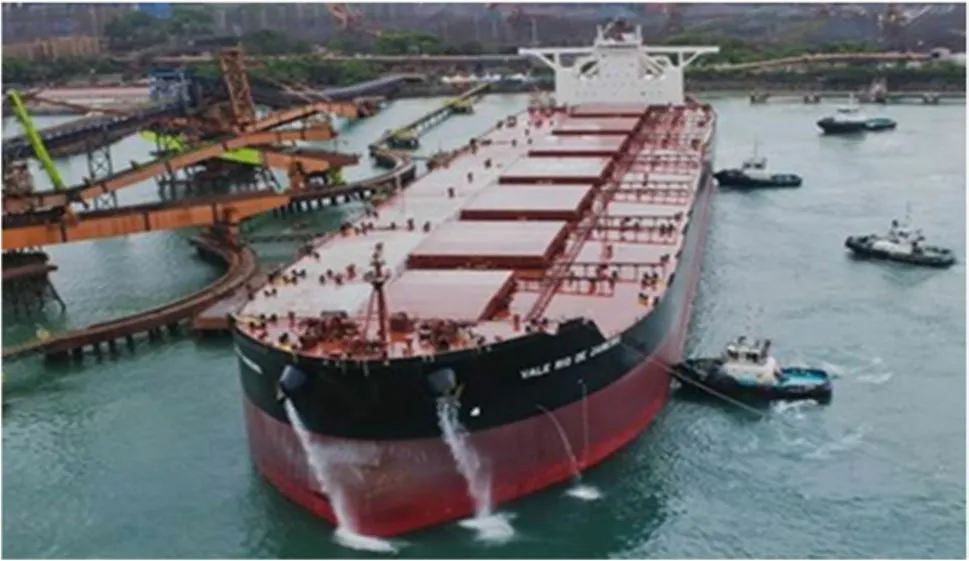
Figure 1 Vessel berthing maneuvering
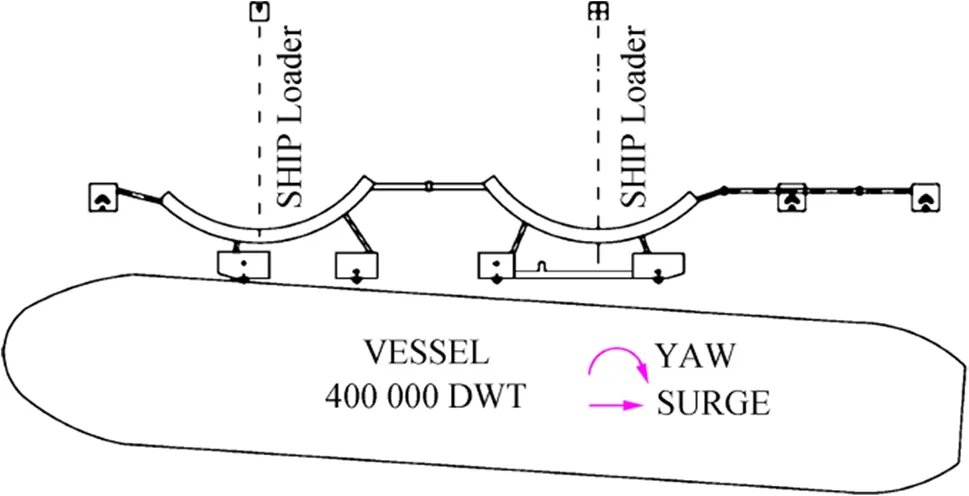
Figure 2 Angle of the approach of the vessel
2.2 Damage Level of Marine Structures
The identification of damages and the level of structural deterioration, along with the recovery of the elements, are a constant concern for harbor maintenance engineers. Del Grosso et al. (2007) state that an agile and precise structural assessment can effectively reduce financial losses and accelerate the restoration of damaged structures to operating conditions.
Civil engineers responsible for pier maintenance recognize the limitations of the commonly practiced visual inspections, and regularly face difficulties to ensure the safety of these structures during service. The exceptional difficulty stems from the accelerated deterioration imposed by maritime environments, characterized by the presence of highly corrosive agents, continuous incidence of waves and currents, in addition to the impact with large vessels.Furthermore, a large part of the structure is submerged and covered with marine life, rendering underwater structural evaluations difficult even for specialized divers.
As such, it is fundamental to determine an analysis approach capable of assessing the present condition of the structure and predicting its remaining lifespan, within standardized serviceability recommendations. The first challenge when determining the failure mechanisms of a given structure is defining which indicators are more relevant to accurately assess its current state. Traditionally,structural investigations are based on searching for cracks and fissures. Depending on the depth and geometry of these pathologies, further computational analyses may be performed if necessary, or direct procedures for recovery and reinforcement may be implemented.
Figure 4 presents a theoretical model for damage progression on a structure proposed by (Griffith 1921), based on a philosophical approach for assessing the accumulation of damage within said structure. It is pragmatic to conclude that the visual perception of pathologies is only possible in advanced stages of structural deterioration,when there is little time to plan preventive actions and corrective solutions that require urgency.

Figure 3 Structural damage caused by the collision of very large vessels in 2006 and 2015

Figure 4 Escalation of structural damage and visual detection (Griffith 1921)
Considering that cumulative damage may cause changes in the physical properties of the structure such as mass and stiffness, it is also possible that modal properties such as natural frequency and modes of vibration are affected.
As explained for (Zhou 2008), analyzing the changes in the frequency of a structure is a relevant additional tool for civil engineers, since these may indicate structural damage in less advanced stages. In this context, techniques for the identification of the modal parameters of a structure, as natural frequency, modes of vibration, and damping ratios,based on in situ measurements, are of considerable interest when attempting to correlate the behavior identified on the field with the validation of numerical models developed to assess the load-bearing capacity of structures.
Corroborating the previous statement, Beskhyroun et al.(2012) performed the continuous monitoring of a bridge inNew Zealand and observed a reduction of 0.05 Hz in the natural frequency of the first mode of vibration after an earthquake. Although small, this change was permanent.
A theoretical study conducted by Lee et al. (2008) modelled a concrete-filled steel box pier, considering different levels of erosion at the support base, which resulted in a reduction of up to 6% in the frequency of the first mode of vibration.
2.3 Operational Vibration Analysis
The dynamic behavior of structures may be experimentally determined using two distinct approaches: the traditional approach, based on measuring the response of the system when subjected to an artificial excitation (impulsive or continuous), and ambient vibration experiments, consisting of determining the dynamic behavior of the structures during actual service conditions.
Due to the large size of civil structures, the traditional approach demands the use of machines that are heavy and therefore difficult to mobilize. This is a result of the high amount of energy required to induce vibration modes of interest. Furthermore, artificial excitations usually require interrupting the operation of the structure under analysis.An example of forced excitation in bridges over bodies of water is the fixation of floaters on the main beams, followed by sudden release of the support cables.
Alternatively, ambient vibration analyses take advantage of existing loads on the structure such as wind, waves,and vehicular traffic. Since it does not require interrupting operations and present a lower cost of implementation, this approach is the most adequate for assessing the dynamic behavior of large structural systems. Pravia and Braido(2015) used a mobile phone to measure the accelerations of a bridge in use, and confirmed the practical potential of this approach.
In this context, this methodology is proven as an excellent tool for defining the level of structural damage in structures, since it is a faster and more economical alternative than the traditional tests using induced dynamic loads. In the ambient analysis, only the actual response of the structure is observed, with its excitation being inherent to its service conditions and the environment in which it is located. As such, there is no need for interrupting the use of the system,and only measuring equipment is necessary, easy to transport and operate. Furthermore, this approach eliminates the installation of cables throughout the structure, drastically reducing the time and labor required to prepare the analysis.
There are two frequently used methods for performing analyses in the frequency domain; the basic PP method(Peak picking), and a more advanced approach called frequency domain decomposition (FDD).
Tavares (2013) performed ambient vibration experiments on a cable-stayed bridge and observed differences under 1%between the PP and FDD methods. FDD shows a better performance when identifying vibration modes with similar frequencies.
On the FDD method, natural frequencies are evaluated based on the peaks of spectral estimates in numerous points.The excitation on the structure is assumed to be caused by a White Gaussian noise (WGN), a stochastic approach in which all frequencies present spectral intensity. The principal hypothesis, however, is that the dynamic response of a frequency close to the natural frequency of the structure is essentially dominated by the contribution of the mode of resonance. This hypothesis characterizes single-degree of freedom (SDoF) methods, since, assuming that this assumption holds at the vicinity of resonance frequencies, the response of the structure may be treated as a SDoF oscillator with the same frequencyωkand the same damping ratioζkof the resonant mode. This approximation is valid when the different modes of vibration of the structure are clearly separated.Figure 5 presents an example of a spectrum with 2 natural frequencies identified with the FDD method.
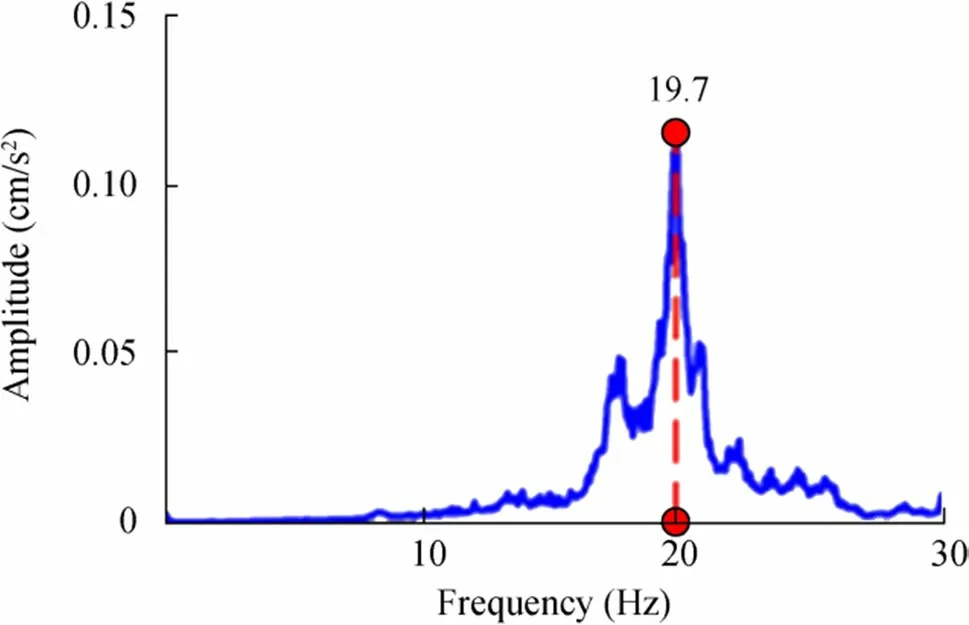
Figure 5 Spectrum with FDD method
In this method, responses measured at different points in the system are analyzed, compared, and used to estimate the spectral density functions of the response. Using the premise of a WGN excitation, Araujo (2012) presents the formulae for determining the spectral density of the system response, from which the dynamic properties are directly determined. As such, the spectral density functions will present peaks with amplitudes that correspond to the natural damped frequencies. This procedure requires converting data obtained in the time domain to the frequency domain and the transformation is usually performed with the Fast Fourier Transform (FFT), since, as stated by (Peeters 2000), this method is characterized by its short processing time.
3 Methodology of Dolphin Analysis
3.1 Structure Under Analysis
A pier usually features a number of breasting and mooring dolphins, the latter of which are not subjected to impacts from vessels and thus excluded from the present analysis.The breasting dolphin studied herein is comprised of a reinforced concrete (RC) block supported by 18 concrete-filled steel tubular shafts with an internal diameter of 104 cm, as shown in Figure 6. The block presents plane dimensions of 15.8 m×10.9 m with a height of 2.0 m, built using structural concrete withFck=18 MPa. The upper surface of the block is located at level+5.0 m considering to sea level (0 m). The modulus of elasticity of concrete of the piles was taken as 23.75GPa with a specific weight of 25 kN/m3.
The steel tubes were driven to level-27.0, with the 6 central tubes driven until-40.0 m. Following the removal of unwanted material from the interior of the tubes, these were filled with structural concrete, reinforced by 12 longitudinal rebars of Ø25mm and spiral stirrups of Ø10mm. The seabed,after dredging operations, is located at-26 m. The inclination of the piles is 1:3.
3.2 Instrumentation
To collect data during the dynamic measuring experiment,a data acquisition system was utilized, connected via cable to a high sensitivity accelerometer, in turn, fixated on the structure. Figure 7 shows the position of the devices on the dolphin.
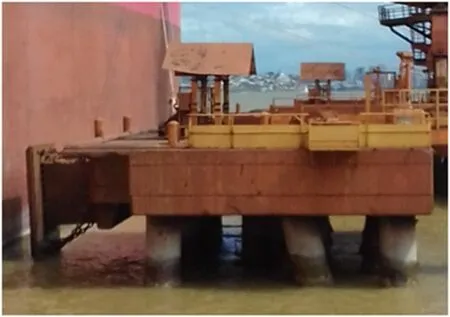
Figure 6 Breasting dolphin
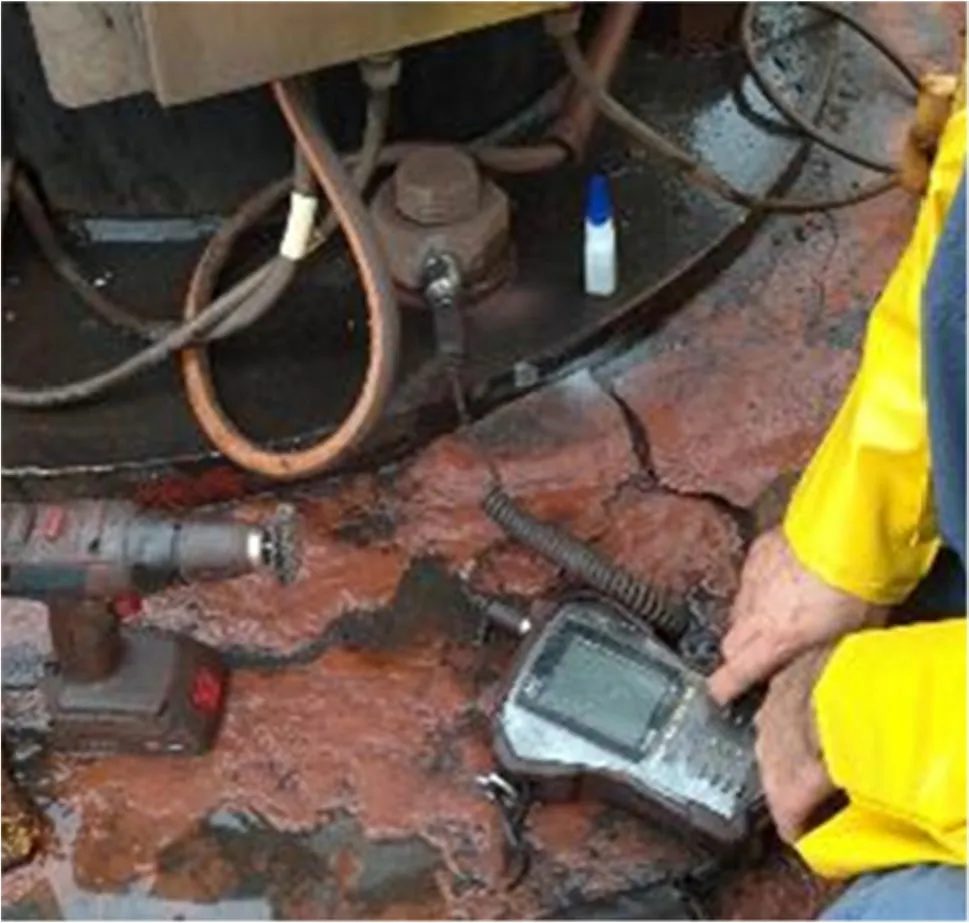
Figure 7 Position of accelerometer and data acquisition system used to perform measurements
The measurement of the dynamic response of the structure without the use of artificial excitations results in the incidence of acceleration functions with small amplitudes,requiring equipment with high sensibility and resolution.The accelerometers used in this study feature a sensibility of 10000 mV/g within a range of-0.5 and+0.5 g. The 24-bit analog converters present a maximum resolution of approximately 4 μg. The models of the accelerometer and converter are 393B12, PCB Piezotronics and the data collector FFT analyzer is of the type Microlog Analyser series GX from SKF®.
The data collector was configured to use the filters defined by the Hanning window. According to Magalhães et al. (2012), this is the most adequate filter window for correcting leakage errors during operational modal analyses. Moreover, Nyquist’s theorem states that the sampling frequency must be double that of the highest frequency to be measured; thus, for a sampling rate of 0-8 Hz, acceptable resolution is obtained for frequencies of up to 4 Hz.
Following recommendations from DIN 45,669-2(Deutsche Industry Norm 2005), the instruments were installed in regions expected to receive the most influence of vibrations on the structure and also to exclude possible points in the modal nodes. During the testing phase, the accelerometer was fixed in the corners and center of the block surface and the best results were obtained in the center of the block, fixed in the 1000-mm embedded bolts of the bollard. Other learning of the testing phase was about the “Z” direction displacements,which were verified, but results observed were not relevant, either due to the higher stiffness of this direction or the absence of vertical service loads on the structure.As such, measurements of displacement were limited to the “X” and “Y” directions, taking “X” parallel to the side of the ship, and “Y” perpendicular to its direction. Data was collected for 22 min.
3.3 Numerical Model
The numerical model was constructed with SAP2000, V 17 developed by Computers and Structures Inc., a commercial software for numerical modeling focused on analysis and design of structural systems, widely used by structural engineers.
The model was based on detailed information from the original design and in situ measurements, performed to verify the dimensions of the most relevant geometric parameters. The piles were modeled as bar elements,with one end fixed at -27 m and the other fixed on the concrete block. The underground portion of the structure was represented by spring supports placed every 1 m along the piles, with an elastic constant ofk=3000 kN/m, in accordance with the original design. The concrete block was modelled as a single shell element with a thickness equal to 2 m. Figure 8 shows the numerical model of the structure.
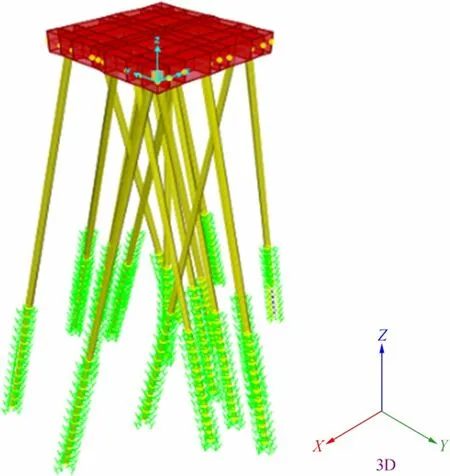
Figure 8 Structural model of the breasting dolphin

Figure 9 Spectrum of the response measured during the experiment
Considering that the dynamic response of this type of structure is mostly influenced by the first and second modes of vibration, the calibration of the numeric model is considered acceptable as long as it accurately represents these two initial frequencies. This approach is corroborated by Soares and Sotomayor (2015) and Doebling et al. (1996).
To determine the initial stiffness of the structural system, three simulations with distinct load configurations were performed. In the first one, the structure is under the influence of a horizontal load of 1000 kN, in theXdirection. The second model is subjected to a load of identical intensity, but in theYdirection. The third simulation consists the application a torsional load of 1000 kN·m on the structure. The stiffness coefficients were determined as a function of the displacements resulting from the loads applied in each simulation. These parameters were obtained by dividing the applied force by the displacement in each of the three cases. The values of initial stiffness are shown in Table 1.

Table 1 Initial stiffness coefficients of the model

Table 2 Frequencies of the initial model
Further details of the numerical model, learnings of testing phase, details of original structural design, bathymetry,and soil probing for the dolphin are available in (Henrique 2019).
3.4 Data Process
The frequency domain decomposition was developed by Brincker et al. (2001) and is based on the theory that it is possible to organize correlation functions using the matrix form as follows (Brincker and Ventura 2015):

whereTis the time duration of records,τis the time lag.Ry(τ) is the correlation matrix, andy(t) is the structure response in vector form given by:

Ais the matrix containing the vibration modes andq(t) a column vector representing the modal coordinates. Replacing (2) in (1), the following equation is reached:

whereRq(τ) is the correlation matrix of modal coordinates.By applying the Fourier transform on both sides of the equation, the spectral density matrix is obtained:

withGy(f) andGq(f) corresponding respectively to spectral density matrix of structure response and modal coordinates.
Assuming that vibration modes are not correlated, then the matrixGy(f) is diagonal and can be synthesized as follows:

Thus, the valuessnof the diagonal matrix ofSare the eigenvalues and represents the natural frequencies ofGy(f).The matrixUcontains the eigenvectors and corresponds to vibration modes of the structure.
4 Results and Discussion
4.1 Vibration Modes of the Initial Model
Table 2 presents the modes of vibration obtained with the numerical model. The first mode, with a frequency of 1.61 Hz, corresponds to the flexure of the piles about the longitudinal axis. The second and third modes, of 2.48 Hz and 3.38 Hz, respectively, are related to rotation about theZaxis. From the fourth to the twelfth mode, rotation about theZaxis with an approximate frequency of 4.00 Hz is repeatedly observed, indicating that the structure is behaving as a rigid body.
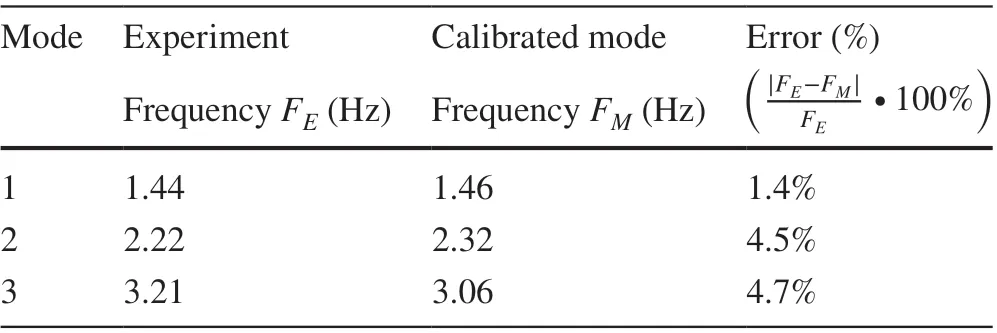
Table 3 Error of analyzed frequencies after calibration of the model
According to EUROCODE-8 (The European Commission 2009), vibration modes with mass participation above 90% must be calibrated. However, the first three modes of vibration of the model show mass mobilization of 63%,35%, and 65% for displacement inX, rotation inZ, and displacement inY, respectively. Although these values are inferior than those prescribed in the European standard,they are coherent, given that the block of concrete corresponds to 41% of the mass of the system as a whole. From the fourth mode on, mass participation is inferior to 1%.
4.2 Experimental Results
The breasting dolphin exhibited three peaks of frequency throughout the experiment, performed during bad weather conditions on December 25, 2018, that induced sea waves of long period (approximately 12 Hz) that hit the vessel berthed on the pier.
As illustrated in Figure 9, the first mode, of 1.44 Hz,and the second, of 2.22 Hz, presented a high peak with a narrow base, characterizing a well-defined mode of vibration, isolated from the structure. The third mode,of 3.21 Hz, presents a broad base surrounded by several peaks in the vicinity.
4.3 Calibration of the Model
In order to calibrate the model to the experimental data,it is necessary to adjust the three vibration modes to the real ones measured. According to Magalhães (2012) and Donahue et al. (2005), the moduli of elasticity (E) are the most suitable factor to reduce its natural frequencies without changing its global behavior.
Considering that vibration modes obtained numerically show acceptable agreement with the experimental data, the tiny adjustment was made by reducing the Moduli of elasticity by 4.9%, from 23.76 to 22.60GPa. Other simulations imputing damages in the block or piles resulted in bigger differences for the first mode.
With the calibration, final divergences for all three vibration modes were inferior to 2% and 5%, as shown in Table 3.Thus, the model is considered well calibrated, that is, an accurate representation of the global behavior of the actual structure. After adjusting the model, the procedure was repeated in order to determine the current stiffness of the structure. Results are shown in Table 4.
4.4 Losses in Stiffness
The reduction of stiffness observed in the axis parallel to the side of the vessel was of 9.7%, while the perpendicular direction shows a reduction of 4.6%. The torsional stiffness was reduced by 8.4%, as shown in Table 5.

Table 4 Final stiffness coefficients of the model

Table 5 Losses in stiffness
These results are consistent with the structural behavior of the dolphin, since the position and slope of the piles provide a higher global stiffness in the perpendicular direction if compared with the longitudinal one. As such, the loss of proportional stiffness was smaller in the most reinforced direction, despite this being the direction bearing the load resulting from the vessel, damped by the existing rubber fenders.
5 Conclusions
This paper presented the results of the ambient vibration analysis of a vessel-breasting dolphin. Accelerations were collected at specific points on the structure and, subsequently, data from the field experiments was processed,allowing the calibration of a numerical model.
The methodology was proven as an efficient tool for structural analysis and assessment of current damages on structures with years of operation. The historical data set for one structure is shown as a key resource for future evaluations of said structure in case of new accidents. The simplicity of this approach can provide quick information on the behavior of the structure is of great relevance for tackling real-world challenges faced by engineers and structural designers.
Given the small divergences observed between numerical and experimental results, the finite element model developed for this research can be regarded as an accurate representation of the actual behavior of the structure, and its capability of providing reliable data concerning its stiffness. Thus, it is concluded that the mathematical model implemented is consistent with the experiments performed.
Ordinary loads resulting from the vessels in contact with the structural system are only applied in the direction perpendicular to these ships (X), as such, the structural design features increased robustness in this direction, in order to properly absorb the loads. The loss of stiffness in this direction is about 4.6%.
On the other hand, the structure shows a reduction in stiffness of 10% in directionYwhen compared to the initial model. It makes sense because the loads applied for the vessel during the accidental contact with the pier start with a very strong lateral friction on the fender and hits the block with some transversal impact, exactly in the less strength direction of the dolphin.
The methodology presented became a very useful tool for monitoring the structural health of the pier and it is an easy way to know the real condition of the structure after new accidents.
杂志排行
Journal of Marine Science and Application的其它文章
- Evaluation of the Double Snap-Through Mechanism on the Wave Energy Converter’s Performance
- Numerical Investigation of Sloshing Under Roll Excitation at Shallow Liquid Depths and the Effect of Baffles
- Analysis of Wave Energy Resources Around the Saint Martin Island in Bangladesh
- Fire Risk Quantitative Assessment of Offshore Supported Platform
- Topside Axial Bearing Wear Under the Eccentric Load of a Single-Anchor Leg Mooring System in Bohai Bay
- Reliability Analysis Method of a Control System for Subsea All-Electric Christmas Tree
